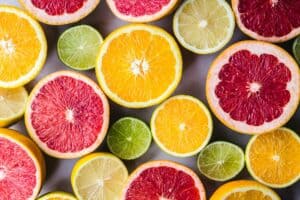Is fermentation the future of steviol glycosides?
Product development • Steviol glycosides are extracted from stevia leaves, refined and turned into stevia extracts. This is how all steviol glycosides are produced in the European market. But in the United States and elsewhere in the world, there are also steviol glycosides made from glucose syrup with genetically modified yeast fungi. What does that mean? What are the advantages and drawbacks? We take a closer look at the matter in this article.
The demand for steviol glycosides is rising. Within a few years, demand is expected to be greater than the supply. In addition, we want the rare but tasty steviol glycosides – like Reb M. This has driven the big American companies to develop methods for producing steviol glycosides through the fermentation of glucose syrup. In this article, we will find out more about how it works and what benefits and disadvantages there are.
Stevia and steviol glycosides
Stevia’s leaves contain sweet substances called steviol glycosides. They all consist of a steviol portion on which one or more glucose moieties hang. The only thing that chemically separates them is the number of glucose moieties and their glycoside binding.
The small variations make a big difference in taste. Most steviol glycosides are stevioside. The dried leaves of stevia contain between five and ten per cent of stevioside. Unfortunately, it has a bitter taste and long and liquorice-like off-taste.
The best tasting steviol glycoside is Rebaudioside M (Reb M). It tastes almost like sugar (except it is up to 350 times sweeter). Unfortunately, there is very little Reb M in the dried leaves. Less than 0.1 per cent.
Other steviol glycosides fall between these extremes in terms of both taste and quantity.
Cheaper
In the EU, 11 steviol glycosides are approved as sweeteners. Of these, Reb M is perhaps the easiest to use. Its sugary taste makes it unproblematic. No taste or aftertaste that needs to be masked.
But the low quantities make Reb M expensive. Therefore, researchers have looked at alternative ways to produce Reb M and other exclusive steviol glycosides.
The environment
Environmental concerns are another reason for developing alternative ways of producing steviol glycosides.
Cultivation of stevia and extraction of steviol glycosides are already much more environmentally friendly today than cultivation of sugar beet and extraction of sucrose. According to one study, water consumption is 92 per cent lower and carbon dioxide footprint 82 per cent lower for the production of stevia extracts compared to the production of beet sugar with the same sweetness.
But soon, the demand for steviol glycosides is expected to exceed supply. And then there is a risk that arable land, which can be used better, will be occupied by stevia cultivation if there is no alternative.

The alternative
Since steviol glycosides are only naturally found in the plant stevia, the search for alternative ways of producing them means a search for a process that can convert another raw material into steviol glycosides.
Today, the food industry uses a wide range of ingredients produced in this way. For example, starch from wheat, potatoes, corn, cassava, rice with several starchy crops is converted into a wide variety of products, including glucose syrup, maltitol and erythritol.
Some of these conversions are purely chemical, such as hydrogenation which converts maltose syrup into maltitol, while others are biochemical, such as fermentation of glucose syrup to erythritol.
Similarly, Reb M and other exclusive steviol glycosides can be prepared by adding yeast fungi that convert glucose syrup to Reb M.
Steviol glycosides produced in this way are not allowed in the EU but are used in the US and elsewhere in the world. It may perhaps be allowed in the EU one day too. Nevertheless, it’s an exciting technique.
Fermentation
Of course, there is no ordinary yeast fungus that converts glucose syrup into Reb M. But it’s also not a magic mushroom. It follows a classic arrangement that has been used for decades.
First, researchers identify what enzymes stevia uses to create Reb M. Then researchers find out what genes make stevia produce these enzymes. Finally, these genes are copied into yeast, which then begins to produce the same enzymes as stevia.
This yeast is then fed with glucose syrup, which in turn is made from corn starch. The result is a super sweet syrup with, among other things, Reb M.
Reb M is then extracted from the super sweet syrup and refined in the same way as steviol glycosides extracted from dried stevia leaves. The result is a stevia extract of high and consistent quality.
Scalable and environmentally friendly
Preparation of Reb M by fermentation of glucose syrup is done in large steel tanks. It is easy to scale up with increased demand. In addition, no arable land is needed that needs plenty of water resulting in large carbon footprints. Thus, it is environmentally friendly, according to the advocates.
But wait a minute, the critics may say. The glucose syrup is made from starch that comes from corn, and corn is grown. So plenty of arable lands must be occupied, albeit indirectly.
Totally correct. But with fermentation you get between five and ten times as much steviol glycoside per hectare of land grown with maize as per hectare cultivated with stevia.
Natural?
Within the EU, conventionally produced stevia extract cannot be marketed as a natural sweetener. In order to be called natural, it must at most have undergone ‘minimal treatment’ (eg peeled, sliced or torn). The process of extracting steviol glycosides is not considered minimal.
(Given that regular sugar is extracted from sugar beet and sugar cane in a similar way, it shouldn’t be considered natural either. But which E-number has sugar?)
Now those who produce steviol glycosides through fermentation hope that these will be considered natural. It is probably a pious hope. And even if it were to be considered natural, consumers might not like it, because there is a thing called GMO.
GMO
The yeast that converts glucose syrup into Reb M contains genetically modified organisms (GMOs). Many consumers are averse to GMO and regard it as something that has nothing to do in food.
But this is not really the case, say the advocates of fermentation. GMO is present in the yeast, but not in the raw material (assuming GMO-free maize is used). And the yeast is killed by heating and then filtered off.
They have a point; many other ingredients in the food industry are also made from genetically modified yeast fungi, and nobody seems to care.

Flip or flop?
Are steviol glycosides produced by fermentation a flip or flop? It remains to be seen.
If they are to be approved in the EU, one of the major producers must first pay for the extensive studies required by the European Food Safety Authority (EFSA). Then consumers have to accept it in food.
It may not even be a flip in the US. Plant refinement, as well as the development of more efficient extraction methods, have simultaneously been underway, which has made it possible to buy Reb M from stevia leaves at a reasonable price. In addition, knowledge has progressed regarding how to mask unwanted side and off-taste, using thaumatin for example.
In any case, it will be exciting to follow the development.
Please, share this article if you liked it.
[et_social_share]





